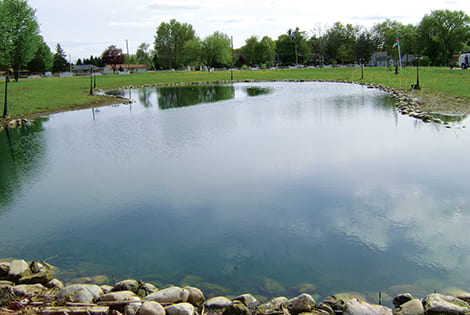Pond cattails and other emergent aquatic plants can add natural beauty to any pond or shoreline, but if left unchecked for too long, they can overtake these areas and create a maintenance nightmare. A consistent program is the most efficient way to combat the excessive spread of unwanted weeds. Fortunately, there is a simple solution to keeping cattails in check. Follow these tips to learn how to get rid of cattails in a pond and maintain a pristine shoreline all season long.
How to Kill Cattails
One of the most effective ways to get rid of cattails is to spray unwanted growth. To maximize the effectiveness of your cattail treatments, wait until there is at least 12" - 18" of exposed growth to apply the product. A systemic herbicide like Shoreline Defense will kill the cattails down to the root to prevent the plant from re-growing. The roots of pond cattails are the most difficult part of the plant to kill, so allow the mixture to absorb into the plant for one to two weeks. This will ensure the treatment penetrates the root system. Do not stretch the application further than the instructions state as this will likely yield poor results and cause you to use more product in the long run.
Dead Cattail Removal
The key to learning how to remove cattails from a pond is to wait until treated cattails are brown and wilted before trying to take them away. Cutting them down too early will prevent the chemical treatment from fully reaching and killing the cattail rhizome (root) resulting in a quick return of the weed. Do not leave dead cattails, or any other dead vegetation, in your pond to decompose. This decomposition turns into nutrient-rich pond muck that fuels new weed growth. Tools like a Weed Cutter and Pond Rake will make the process quick and simple.
Setting Boundaries
While knowing how to kill cattails in a pond is helpful for maintenance, there are benefits to having cattails. They add some privacy and a small, managed area of cattails can provide an ideal habitat for amphibians, insects, birds, and fish. These aquatic critters use the plants for all sorts of things:
- Nesting Spot: Red-winged blackbirds often use cattails for a perching and nesting spot. Waterfowl, like mallards and Canadian geese, also use the tall, tightly bunched leaves and stalks for nesting. Turkeys - as well as deer, raccoons and other mammals - use cattails as cover from predators.
- Hatchery/Nursery: Birds and mammals aren't the only ones that find refuge in cattails. Insects and amphibians, like dragonflies, frogs, and salamanders, will lay their eggs in the brush and water between the stalks. Below the surface, fish and other aquatic creatures will hide and nest in the growth.
- Multi-Purpose Material: The cattail fluff that explodes from the plant's spikes makes excellent nest-making material for birds, but that's not all it's good for. Native Americans used it to cushion moccasins and papoose boards. Pioneers used it to dress wounds, start campfires, and stuff quilts, cushions, mattresses, and dolls. And the military used the water-resistant, buoyant fluff to stuff life vests. Besides the fluff, the cattail's leaves were used to make mats and webbing, and the stalks were used to make fiber and adhesive.
- Grocery Store: An integral part of the pond ecosystem's food chain, cattails' leaves, shoots, and roots make a tasty buffet for muskrat, geese and snails, while the plant's underwater stalks feed fish, frogs, and turtles. Humans can eat cattails, too. The rhizomes can be used like other root vegetables, and they can be dried and ground into flour. Young green shoots, which taste like cucumber, can be chopped into salads. Green flowering stalks can be boiled and eaten like sweet corn.
Like most things, however, cattails are best in moderation. Highlight boundaries to contain pond cattails by using landmarks, rocks, or other unobtrusive markers. Treat and remove cattails that try to stray from these boundaries to keep their growth under control.
Treat Again As Needed
Because pond cattails have a robust root base, multiple treatments may be necessary to properly gain control. Once you find a balance and learn how to get rid of cattails when necessary, they will make a nice addition to your landscape and encourage wildlife to call your pond home. If you have any questions as you work, don't hesitate to contact our customer service team for help.



